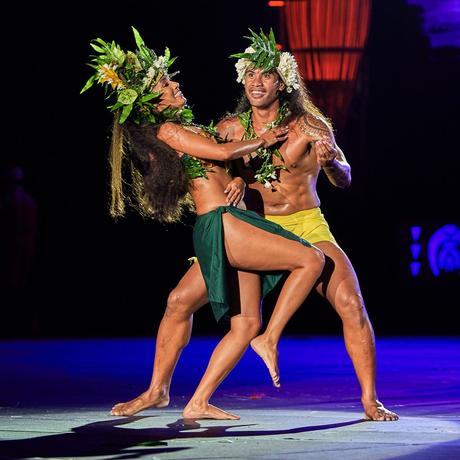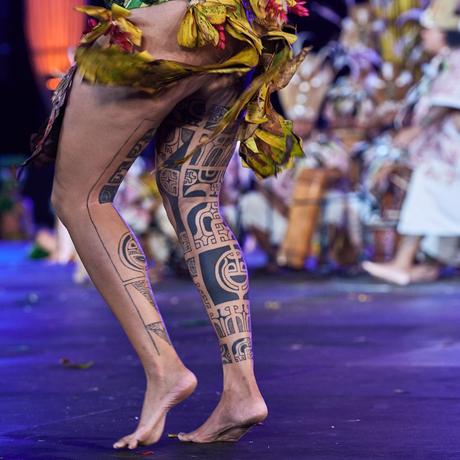![]() Heiva is not only about Thaiti history, but dancing groups from other Pacific islands also bring their own tales. Like the group from Rurutu. On this island a peculiar new year festival takes place, with open doors to private houses and celebrations through the island for wishing everybody a good new year. For the occasion, Rurutu citizens call for a good new year by lifting volcanic stones up to 170 Kgs.
Heiva is not only about Thaiti history, but dancing groups from other Pacific islands also bring their own tales. Like the group from Rurutu. On this island a peculiar new year festival takes place, with open doors to private houses and celebrations through the island for wishing everybody a good new year. For the occasion, Rurutu citizens call for a good new year by lifting volcanic stones up to 170 Kgs.
Some other stories explain the migration of the white flower
tiare, which many women still fit in their hair. Tiare, Linn.
Gardenia taitensis, is the national flower of the islands of Tahiti. Flowers and other medical plants were brought by Polynesian through the archipelagos. Tiare was spread by Hinaraure’a, a beautiful girl from Maurua.
The history of Polynesia is strongly correlated with sailing. The God of Thieves, Hiro (the one who also split the island of Huaine in two, after he got asleep during the trip) left his island Rangihā and reached Hawaii in the far North. He was the first builder of large canoes
with planks sewn together called pahi. This is one of the most amazing examples of wide navigation and exploration in Polynesian mythology.
War strategies are also topics of Heiva. One of the most famous example is the legend of Queen Maupiti. The queen, scared because of the imminent attack from Bora Bora, lit every evening hundreds and hundreds of torches on her island, Tapua’emanu. This way, it looked like the island was strongly defended by its inhabitants at guard. When the king of Bora Bora and his soldiers silently approached Tapua’emanu by night on pirogues, he had to give up with his military plans, scared by the multitudes of soldiers (torches) on Tapua’emanu.
Singing
toponymies might sound odd, it is instead important to keep memory of Polynesian origins. For example, the name of Mo’ore’a island means yellow lizard in Tahitian. Lizards are common in Polynesian mythology. The name of Mo’ore’a reminds the story of Tema’atea and his wife, who gave birth first to a dog-baby, abandoned to death. The second child the couple got was a lizard-baby, who got also abandoned on a different island. Before death came, the yellow lizard-baby turned its yellow belly up and flushed the actual island of Moorea with that intense yellow light you can see at every sunset.
Each Wednesday, Friday and Sunday the following episodes will be published and links will be activated at 11AM CEST of the scheduled date:
September 2023-
0. French Polynesia: my displacement in time – from 6.9.23
1. Dots in the ocean – from 8.9.23
2. With wet ankles in Big Moana – from 10.9.23
3. Would you mind bringing the fruit? Be quick! – from 13.9.23
4. Coconut split – from 15.9.23
5. Moana’s ritual – from 17.9.23
6. On the road to the Rock of Displacement – from 20.9.23
7. A dangerous hug – from 22.9.23
8. It’s war! – from 24.9.23
9. Heiva nights: dancing the myth– from 27.9.23
10. Catch the fight – from 29.9.23
– October 2023-
11. Another portion of fruit, please – from 1.10.23
12. Lift it if you can – from 4.10.23
13. Keep Moorea always on your mind – from 6.10.23
14. Allons enfants de la Patrie a Tahiti! – from 8.10.23
15. Return to the Spear Age – from 11.10.23
16. What’s on in Papeete – from 13.10.23
17. Teahupo‘o, surf for the gold medal – from 15.10.23
18. Papeete open air – from 18.10.23
19. Heiva nights: back to the origins – from 20.10.23
20. Va’a: the displacement in time – from 22.10.23
21. Va’a: the competition – from 25.10.23
22. Heiva nights: across time – from 27.10.23
23. Heiva the champions – from 29.10.23
– November 2023 –
24. Don’t wake up Te Fiti – from 1.11.23
25. Sharks ahead! – from 3.11.23
26. Na na Huahine – from 5.11.23
Heiva is not only about Thaiti history, but dancing groups from other Pacific islands also bring their own tales. Like the group from Rurutu. On this island a peculiar new year festival takes place, with open doors to private houses and celebrations through the island for wishing everybody a good new year. For the occasion, Rurutu citizens call for a good new year by lifting volcanic stones up to 170 Kgs.



